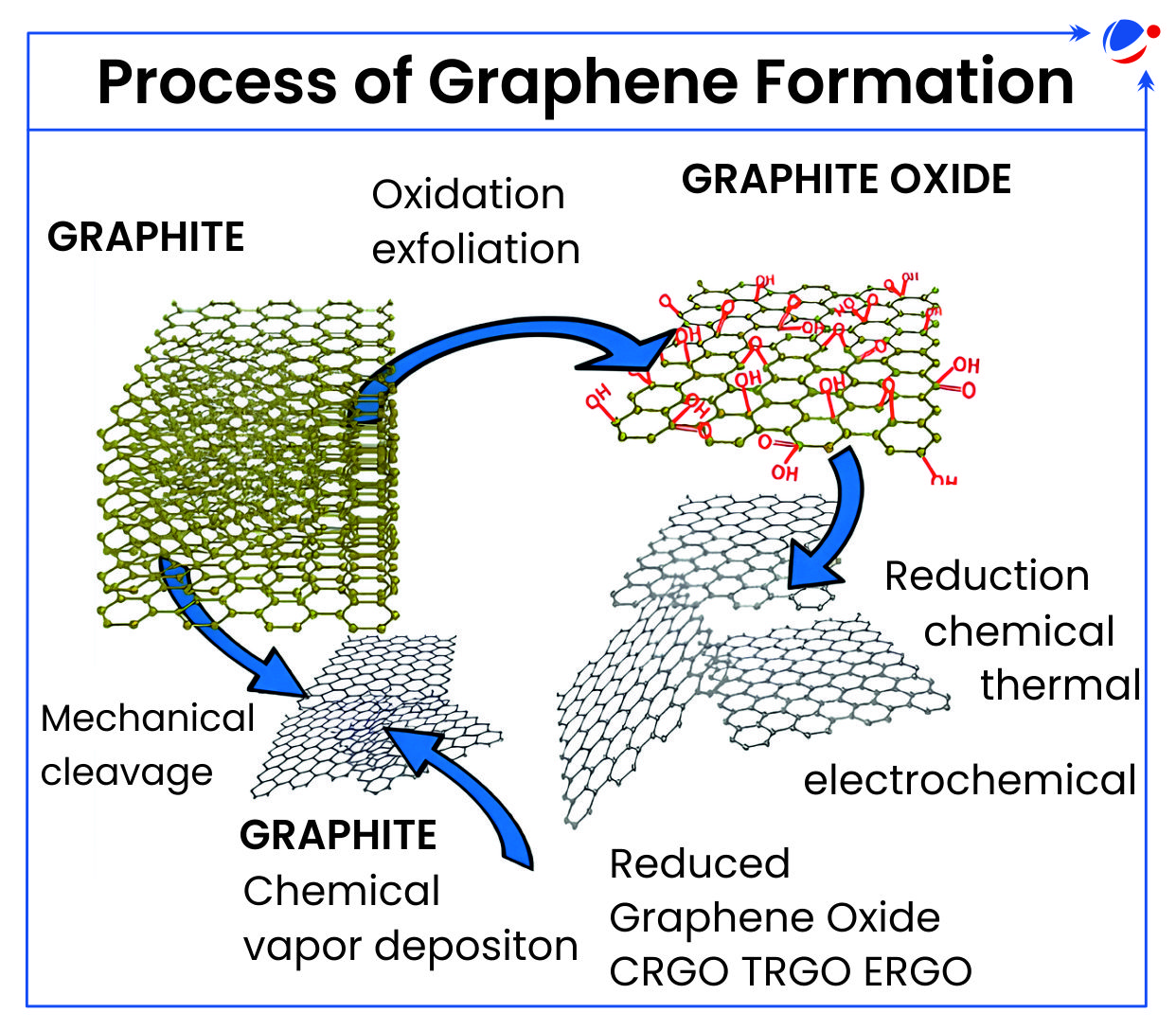Why in the News?
Recently, Union Ministry of Electronics and Information Technology (MeitY) launched India Graphene Engineering and Innovation Centre (IGEIC) under the vision of Viksit Bharat@2047.
About India Graphene Engineering and Innovation Centre (IGEIC)
- About: It is the not-for-profit company (registered under Section 8 of the Companies Act, 2013).
- Purpose: It is exclusively incorporated to create a hub of excellence in Graphene technology commercialization.
- Focus: On a range of applications such as electronics, energy storage, healthcare, material coating, conveyance systems, and sustainable material development.
- R&D setup in Trivandrum (Kerala).
- Corporate & Business Development hub in Bangalore (Karnataka).
What is Graphene?

- Discovered in 2004 by Andre Geim and Konstantin Novoselov, who received the Nobel Prize in Physics for this in 2010, it is an allotrope of Carbon and building-block of Graphite (which is used in pencil tips).
- It is a single layer (2D-dimensional) of carbon atoms, tightly bound in a hexagonal honeycomb lattice.
- Methods for the synthesis of Graphene sheets: Chemical vapour deposition (CVD), cleavage of natural graphite, mechanical exfoliation, hydrogen arc discharge, etc.
- It is often referred to as a wonder material for its extraordinary electrical and electronic properties.
Properties of Graphene
- Mechanical Strength: It is 200 times stronger than steel, yet 6 times lighter.
- Optical Transparency: In the optical region it absorbs only 2.3% of the light. Making it suitable for transparent touchscreens, solar cells, and display technologies.
- High Thermal Conductivity: Graphene has a thermal conductivity of up to 5000 W/m/K at room temperature, which is much higher than most other materials.
- Impermeability: It is impermeable to gases, even those as light as hydrogen and helium.
- Quantum Properties: Quantum Hall effect in Graphene could also possibly contribute standard in metrology, quantum computing and advanced electronics.
Potential Applications of Graphene
- Electronics Industry: Due to superior speed and energy efficiency compared to silicon, it can be used to develop Graphene-based semiconductors.
- Energy Storage: Graphene has an extremely high surface area (2630 m²/g), which makes it useful for energy storage devices like batteries and supercapacitors.
- Water filtration technology: Depending on the pore size and the applied pressure, Graphene nanoporous membranes have an efficiency range of 33% to 100% for desalination and filtering of water.
- Environmental: It has been demonstrated that Graphene can absorb liquids 600 times heavier than itself.
- Additionally, ethanol, olive oil, nitrobenzene, acetone, and dimethyl sulfoxide may all be adsorbed by Graphene.
- Biomedical: Its oxidised form, called Graphene Oxide (GO), offers low cytotoxicity, making it suitable for medical applications.
- e.g., Tissue engineering, drug/gene delivery, phototherapy, cellular growth and differentiation, biosensors, bio-imaging, cancer or disease detection, etc.
- Defence and Security: Graphene exceptional strength makes it promising material for armour and ballistic protection.
Challenges in Graphene
- Human Health Risk: A study has proved that Graphene oxide and Graphene toxicity destroy the lipid membrane after coming in direct contact with the human cell membrane, which comes out to be very dangerous.
- High Production Costs: The customer base is narrowed and market growth is impeded by these costs, which limit extensive adoption, particularly in price-sensitive sectors.
- Band gap problem: Graphene lacked a band gap, preventing its use in electronics, as the band gap is essential for semiconductors to switch on and off.
- Limited production: Graphene production is severely limited and for years, it was only produced in small amounts. Although there is a way to mass-produce Graphene, the quality of the end product is typically worse.
Global Scenario
|
India's Initiatives to promote Graphene
- Graphene-Aurora program: To fill the gap between R&D and commercialization by providing a complete facility to startup and industry.
- India Innovation Centre for Graphene (IICG): Set up in Kerala, it is a joint venture of the Digital University of Kerala, Centre for Materials for Electronics Technology (C-MET) and Tata Steel Limited funded by MeitY.
- Research Institution: IIT Roorkee-incubated Log 9 has patented a technology for Graphene-based ultracapacitors and Centre for Nano and Soft Matter Sciences (CeNS) is actively involved in Graphene research.
Conclusion
Ongoing research is driving innovations in Graphene composites, hybrid materials, and scalable processing techniques. As these efforts mature, Graphene could become a cornerstone material, enabling breakthroughs in high-performance devices, energy efficiency, and sustainable technologies across multiple sectors.



